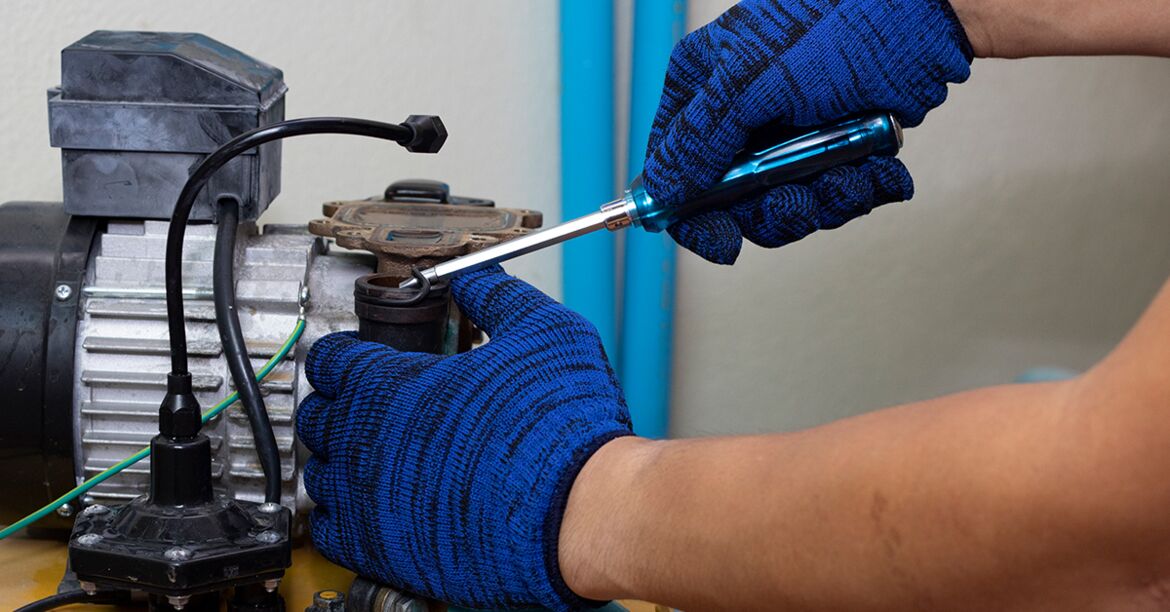O-rings - prevent damage and increase service life


O-rings are extremely versatile and are therefore used in a wide range of applications in industry and everyday life. However, their reliability and tightness is not only dependent on the right material and its specific properties: How long and effectively an O-ring lasts is influenced by many factors, such as the correct bearing, applied lubricants and correct assembly.
In this article, we will provide you with some measures to prevent damage to the popular sealing rings, increase their service life and at the same time reduce costs due to excessive replacement.
Function and use of O-rings
Each area of application demands certain properties from the material, which can be covered by the right choice of material.
The advantages of O-rings as sealing elements lie in the large selection of materials, which enables a wide range of applications, and in their uncomplicated manufacture, which ensures economical prices.
O-rings can be used as sealing elements in various ways:
- As a static sealing element in a groove to prevent liquids or gases from escaping
- In dynamic applications, e.g. as piston or rod seals in hydraulic cylinders
Even though O-rings are easy to handle, there are a few points that you should bear in mind when using and storing them in order to benefit from the longest possible use of the sealing material.
Prevention of damage and premature wear and tear
A seal that is no longer fully functional will result in leakage. This can result in costly machine downtimes and thus cause economic damage.
But what causes damage to O-rings and how can you prevent it? Below we have summarized the most common causes of damage for you, explain how you can recognize the respective cause and how you can prevent a problem from occurring:
Avoid excessively high temperatures
The longer O-ring materials are exposed to their maximum possible temperature, the longer their service life decreases. Therefore, if high demands are placed on the service life of the sealing element, there should be a certain “temperature cushion” at the top.
Damage pattern: Exceeding the short-term upper temperature limit usually manifests itself in cracks in the surface of the O-ring. If, on the other hand, the permissible operating temperature is exceeded within the typical polymer temperature range, this usually manifests itself in embrittlement or permanent deformation.
Solution: When selecting O-ring materials, make sure that the maximum temperature to be expected in the application is not the same as the maximum temperature of the material. It has a positive effect on the service life of the sealing element if the material can withstand slightly higher temperatures.
Ensure correct installation
The optimum sealing effect is achieved, depending on the application and cord thickness of the O-rings, when the cross-section is compressed between 10 and 30%.
The following errors are possible during assembly:
- Sharp edges could damage O-rings when pressed on due to the resulting deformation forces.
- A radially sealing O-ring is fitted without - or with too steep - an insertion chamfer.
- Sharp-edged grooves are overlooked or ignored.
Damage pattern: The O-rings show cracks and damage.
Solution: If in doubt, only have O-rings fitted or replaced by qualified personnel. The following tips will help you to ensure reliable installation:
- Using the correct lubricant can reduce the assembly forces that arise.
- When using or replacing O-rings, ensure that the working environment, materials and equipment used are clean.
- Do not reuse dismantled rings.
- Eliminate sharp edges and transitions.
Correct choice of material in terms of resistance, swelling and shrinkage
O-rings that have not been selected with the intended use in mind pose a risk: This can lead to leaks or insufficient service life and thus to machine and system failure. Light sources that generate UV light increase the ozone content indoors, which can cause elastomers to crack. Ensure that the O-rings are adequately packaged, e.g. in UV-impermeable or black bags.
Damage to the O-ring can be caused by chemical swelling or chemical shrinkage.
For static applications, a volume swelling of 15-20% is generally considered acceptable. However, higher swelling rates cause groove overfilling, which results in the destruction of the O-ring.
In dynamic applications, on the other hand, a volume swelling of more than 8-10% already leads to significantly higher friction. This results in a decrease in the abrasion resistance, load capacity and service life of the O-ring.
Shrinkage of the O-ring is usually caused by surrounding media, such as lubricants, which remove plasticizers from the O-ring. Shrinkage means that a reliable seal is no longer possible.
Damage pattern: A lack of resistance, swelling or shrinkage usually manifests itself in the form of embrittlement of the O-ring, whereby detached particles can pose a risk to machines and systems. Damage can also manifest itself in a sticky sealing surface or softening of the ring.
Solution: Consult a resistance table when selecting the right O-ring and its material. This provides a lot of important information and points of reference to prevent a chemical reaction with other media. Alternatively, you can seek advice from a sealing expert who is familiar with the interaction of different components and their reactions.
Selection of lubricants
The use of suitable lubricants is particularly recommended for dynamic applications in order to prevent abrasion caused by excessive and repetitive friction between the O-ring and its surroundings.
However, an unsuitable lubricant or improper lubrication can also lead to damage or chemical reactions.
Damage pattern: The surface of the O-ring shows clear abrasion and, in the case of heavy wear, deep cracks or fractures. A chemical reaction leads to swelling, bubbles, discoloration or changes in hardness on the ring.
Solution: It is essential that you pay attention to whether and how the use of a lubricant is required for the O-ring to function smoothly. When using lubricants, pay attention to the resistance and possible reactions of the O-ring material used. If you know that the O-ring is permanently exposed to increased friction, you should seek advice and choose a product with optimum abrasion resistance.
Prevent damage to O-rings with correct storage
The correct storage of rubber products is a decisive factor in preventing cracks, deformation or hardening in advance. If the properties change due to incorrect storage, the parts can no longer be used.
Exactly how long O-rings can be stored depends on the material and the storage environment. If stored properly, sealing rings can easily retain their properties for several years. A good guideline is provided by the regulation on the storage of elastomers in DIN 7716.
Here are some key points for the optimum storage of O-rings:
- The storage room should be dry, cool, as dust-free as possible and only moderately ventilated.
- The exact storage temperature depends on the material used and the type of product. For elastomer seals, the average temperature is +15 °C to 25 °C.
- In heated storage rooms, the heat source must be shielded and should be at least one meter away from the stored goods.
- The ideal air humidity is 65%.
- Avoid direct sunlight and strong artificial light with a high ultraviolet content.
- Prevent strong air changes or draughts.
- Store the O-rings well packaged, preferably in the original packaging.
- Do not store fuels, lubricants, acids, disinfectants, solvents or other chemicals in the same room.
- Keep new products separate from older ones during longer storage periods.
- Avoid high weight loads, pressure, tension or other external mechanical influences in order to prevent damage.
Longer service life thanks to suitable lubricants
As already mentioned, not every O-ring material is compatible with every lubricant. It is easiest to follow the instructions provided by the manufacturer.
The selection of the correct lubricant depends on the following criteria:
- It must not cause shrinkage or swelling
- Lubricity must be maintained at all temperatures
- No components may separate or deposit
- The lubricant film must adhere in such a way that it is not removed by the O-ring
- Compatibility with the media coming into contact must be guaranteed
- The lubricant must not block an existing filter
For best results, apply lubricant to both the O-ring and the surface it comes into contact with.
Exceptions
There are special cases where the use of external lubricants is not possible. In this case, there are two possible alternatives:
Option 1:
There are O-rings that are made from materials (e.g. MVQ or NBR) in which the lubricant is already enclosed. This lubricant then gradually migrates to the surface of the O-ring.
Option 2:
There are so-called dry lubrications. These are applied to the O-rings as a special coating in the form of a bonded coating. O-rings coated in this way have a permanently low coefficient of friction and consistently good dry-running properties. The advantage is that this method is suitable for coating mass-produced parts and, for example, the occurrence of the so-called stick-slip effect (jerky sliding) can be prevented.
Conclusion
The longest possible service life for O-rings ensures stable running times for your machines and systems. You should therefore avoid damage from the outset and observe a few points to increase the service life of the O-rings used:
Only use O-rings for the intended function (material selection!).
Prevent damage caused by incorrect installation, high temperatures or chemical reactions.
Observe DIN 7716, the standard for the storage of elastomers.
Only use lubricants that are compatible with the respective O-ring.
In general, before using an O-ring, it is always advisable to check which material it is made of and what properties and resistance it has. If you select the right O-ring for the intended use from the outset, you have the best chance of ensuring a long service life for your O-ring.
Our tip: If O-rings in machines or systems are frequently damaged, it is worth taking a closer look at the damage pattern and finding out the possible cause of the damage. This can greatly reduce future failures. The best way to do this is to contact a sealing specialist who can not only help you find the cause, but can also advise you on suitable alternatives. Book your appointment now!


Book your individual consultation appointment now!
Talk to our experts to find out everything you need to know about our products and services. Book your online appointment now and work with us to find the right solution for your application!



